Analysis of Leadership, Management, and Operations at Volkswagen Group
VerifiedAdded on 2024/05/30
|18
|3982
|184
Report
AI Summary
This report provides a comprehensive analysis of leadership and operations management within the Volkswagen Group. It differentiates between the roles of leaders and managers, examining their characteristics and functions in various situational contexts. The report applies different leadership theories, including situational, systems, and contingency leadership, and explains key approaches to operations management such as Total Quality Management (TQM) and Just In Time (JIT). It also assesses the impact of the business environment on operational management and decision-making, highlighting the importance of effective leadership and management in achieving business objectives within the Volkswagen Group. The report concludes by emphasizing the need for continuous improvement through the implementation of effective leadership and management strategies.
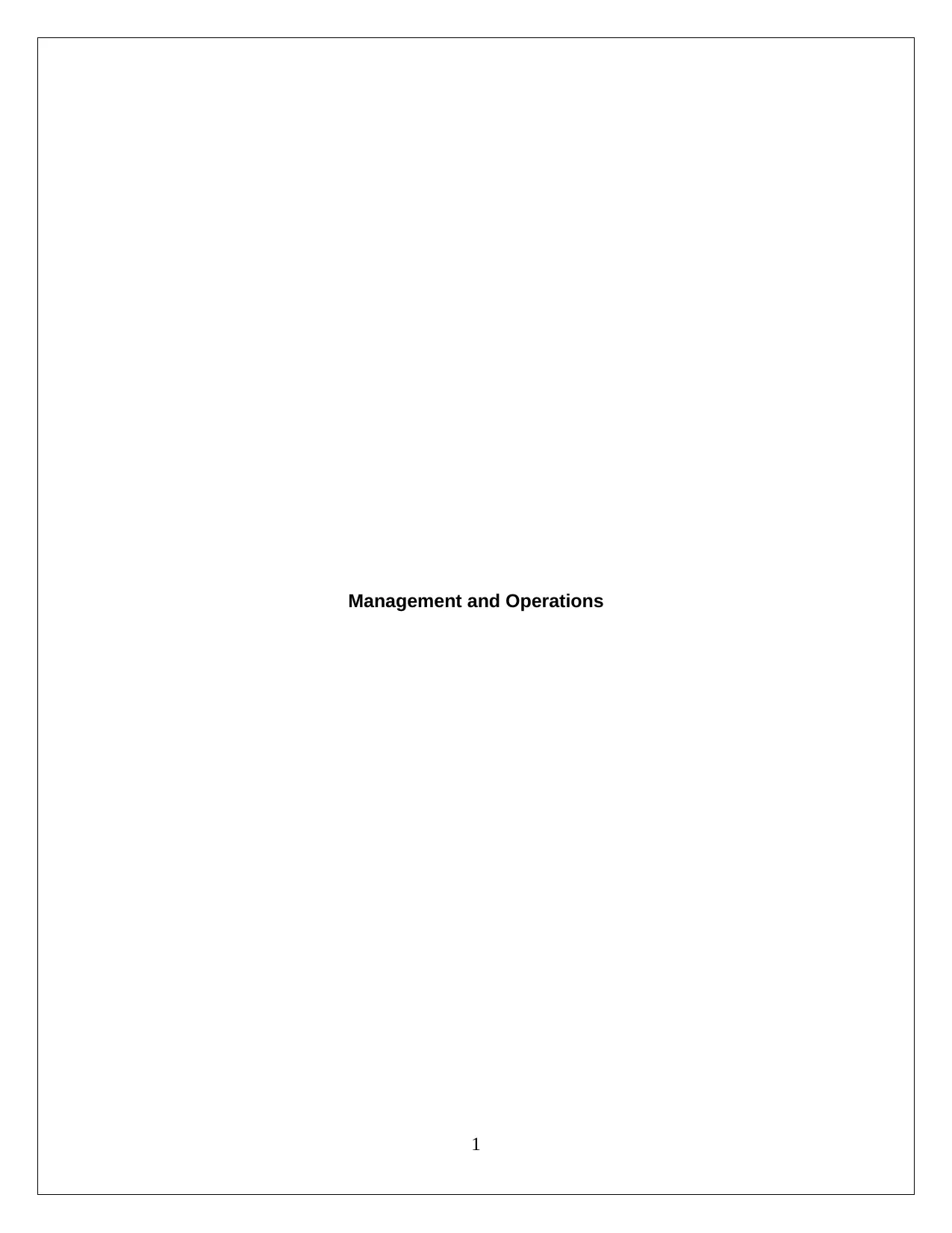
Management and Operations
1
1
Paraphrase This Document
Need a fresh take? Get an instant paraphrase of this document with our AI Paraphraser
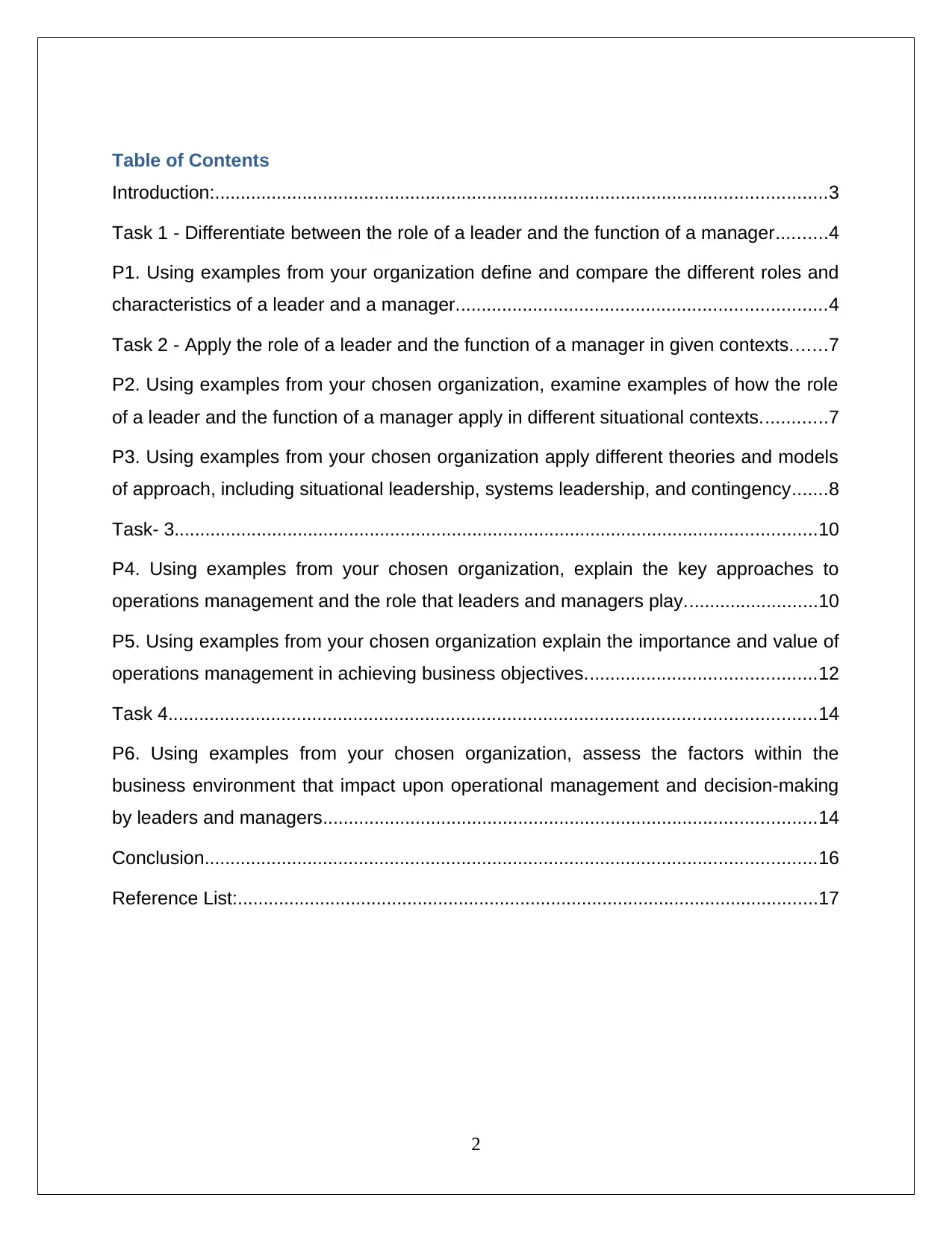
Table of Contents
Introduction:.......................................................................................................................3
Task 1 - Differentiate between the role of a leader and the function of a manager..........4
P1. Using examples from your organization define and compare the different roles and
characteristics of a leader and a manager........................................................................4
Task 2 - Apply the role of a leader and the function of a manager in given contexts.......7
P2. Using examples from your chosen organization, examine examples of how the role
of a leader and the function of a manager apply in different situational contexts.............7
P3. Using examples from your chosen organization apply different theories and models
of approach, including situational leadership, systems leadership, and contingency.......8
Task- 3.............................................................................................................................10
P4. Using examples from your chosen organization, explain the key approaches to
operations management and the role that leaders and managers play..........................10
P5. Using examples from your chosen organization explain the importance and value of
operations management in achieving business objectives.............................................12
Task 4..............................................................................................................................14
P6. Using examples from your chosen organization, assess the factors within the
business environment that impact upon operational management and decision-making
by leaders and managers................................................................................................14
Conclusion.......................................................................................................................16
Reference List:.................................................................................................................17
2
Introduction:.......................................................................................................................3
Task 1 - Differentiate between the role of a leader and the function of a manager..........4
P1. Using examples from your organization define and compare the different roles and
characteristics of a leader and a manager........................................................................4
Task 2 - Apply the role of a leader and the function of a manager in given contexts.......7
P2. Using examples from your chosen organization, examine examples of how the role
of a leader and the function of a manager apply in different situational contexts.............7
P3. Using examples from your chosen organization apply different theories and models
of approach, including situational leadership, systems leadership, and contingency.......8
Task- 3.............................................................................................................................10
P4. Using examples from your chosen organization, explain the key approaches to
operations management and the role that leaders and managers play..........................10
P5. Using examples from your chosen organization explain the importance and value of
operations management in achieving business objectives.............................................12
Task 4..............................................................................................................................14
P6. Using examples from your chosen organization, assess the factors within the
business environment that impact upon operational management and decision-making
by leaders and managers................................................................................................14
Conclusion.......................................................................................................................16
Reference List:.................................................................................................................17
2

Introduction:
Operations management is that area of management, which is concerned with the
control and the design of the day-to-day operation of the business. This department
solely depends on the leaders and managers who are responsible for the management
of the operation of the organization.
The Volkswagen group is one of the largest automobile manufacturers, which is
operating all over the world. Some of the well-known competitors are Toyota, General
Motors, Ford, Renault Nissan, Hyundai, and BMW. The recent statistics have shown
that the company’s revenue is € 230.682 billion. Approximately an employee count of
642,292 is recorded in the year 2017 and is still increasing. This study will be
highlighting on the important factors of business operations and management in
accordance to the Volkswagen Group. This study will throw light on the roles and
functions, importance and the needs of leaders and managers. It will also be discussed
how improvements can be brought forward with the use of effective leadership and
management.
3
Operations management is that area of management, which is concerned with the
control and the design of the day-to-day operation of the business. This department
solely depends on the leaders and managers who are responsible for the management
of the operation of the organization.
The Volkswagen group is one of the largest automobile manufacturers, which is
operating all over the world. Some of the well-known competitors are Toyota, General
Motors, Ford, Renault Nissan, Hyundai, and BMW. The recent statistics have shown
that the company’s revenue is € 230.682 billion. Approximately an employee count of
642,292 is recorded in the year 2017 and is still increasing. This study will be
highlighting on the important factors of business operations and management in
accordance to the Volkswagen Group. This study will throw light on the roles and
functions, importance and the needs of leaders and managers. It will also be discussed
how improvements can be brought forward with the use of effective leadership and
management.
3
⊘ This is a preview!⊘
Do you want full access?
Subscribe today to unlock all pages.

Trusted by 1+ million students worldwide
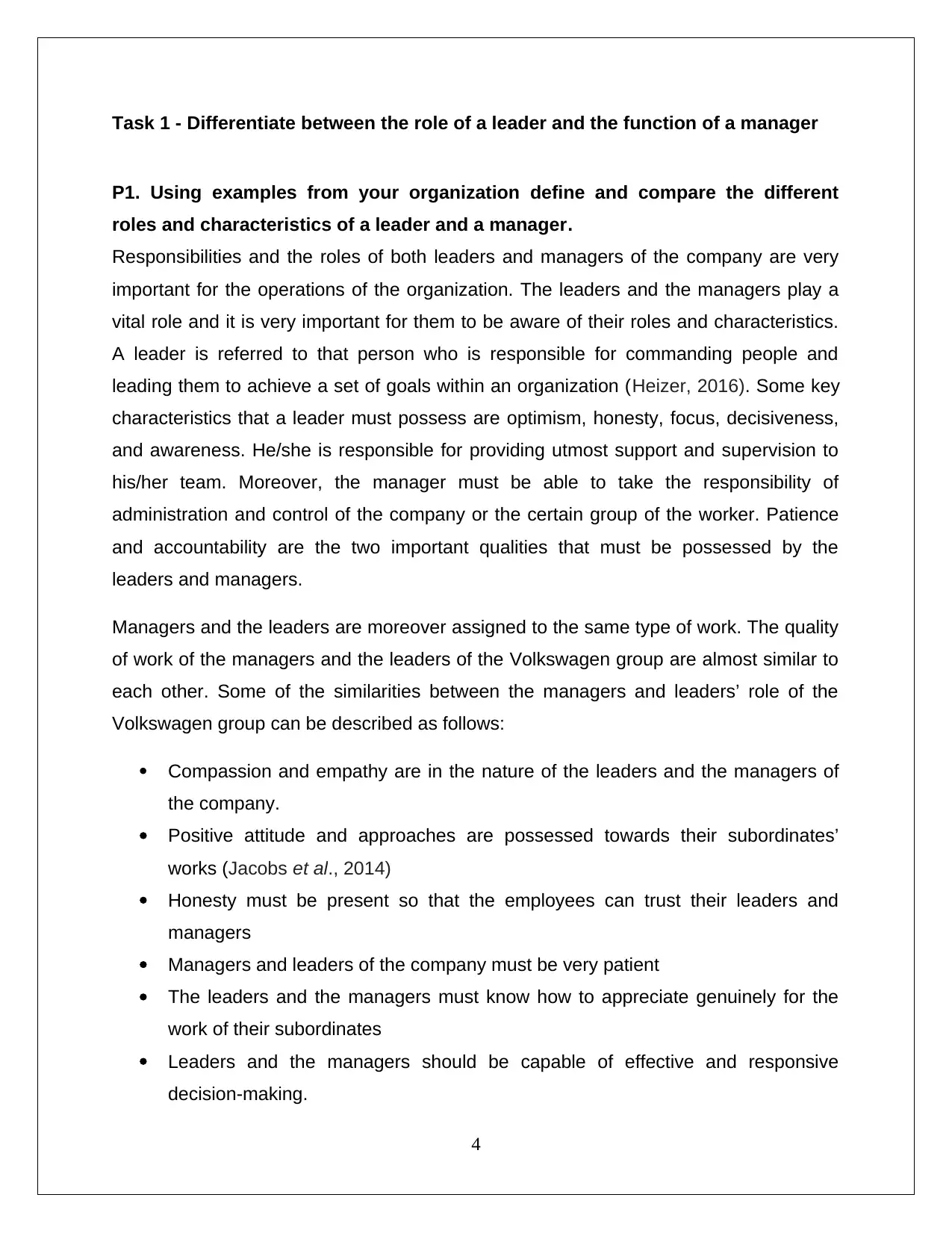
Task 1 - Differentiate between the role of a leader and the function of a manager
P1. Using examples from your organization define and compare the different
roles and characteristics of a leader and a manager.
Responsibilities and the roles of both leaders and managers of the company are very
important for the operations of the organization. The leaders and the managers play a
vital role and it is very important for them to be aware of their roles and characteristics.
A leader is referred to that person who is responsible for commanding people and
leading them to achieve a set of goals within an organization (Heizer, 2016). Some key
characteristics that a leader must possess are optimism, honesty, focus, decisiveness,
and awareness. He/she is responsible for providing utmost support and supervision to
his/her team. Moreover, the manager must be able to take the responsibility of
administration and control of the company or the certain group of the worker. Patience
and accountability are the two important qualities that must be possessed by the
leaders and managers.
Managers and the leaders are moreover assigned to the same type of work. The quality
of work of the managers and the leaders of the Volkswagen group are almost similar to
each other. Some of the similarities between the managers and leaders’ role of the
Volkswagen group can be described as follows:
Compassion and empathy are in the nature of the leaders and the managers of
the company.
Positive attitude and approaches are possessed towards their subordinates’
works (Jacobs et al., 2014)
Honesty must be present so that the employees can trust their leaders and
managers
Managers and leaders of the company must be very patient
The leaders and the managers must know how to appreciate genuinely for the
work of their subordinates
Leaders and the managers should be capable of effective and responsive
decision-making.
4
P1. Using examples from your organization define and compare the different
roles and characteristics of a leader and a manager.
Responsibilities and the roles of both leaders and managers of the company are very
important for the operations of the organization. The leaders and the managers play a
vital role and it is very important for them to be aware of their roles and characteristics.
A leader is referred to that person who is responsible for commanding people and
leading them to achieve a set of goals within an organization (Heizer, 2016). Some key
characteristics that a leader must possess are optimism, honesty, focus, decisiveness,
and awareness. He/she is responsible for providing utmost support and supervision to
his/her team. Moreover, the manager must be able to take the responsibility of
administration and control of the company or the certain group of the worker. Patience
and accountability are the two important qualities that must be possessed by the
leaders and managers.
Managers and the leaders are moreover assigned to the same type of work. The quality
of work of the managers and the leaders of the Volkswagen group are almost similar to
each other. Some of the similarities between the managers and leaders’ role of the
Volkswagen group can be described as follows:
Compassion and empathy are in the nature of the leaders and the managers of
the company.
Positive attitude and approaches are possessed towards their subordinates’
works (Jacobs et al., 2014)
Honesty must be present so that the employees can trust their leaders and
managers
Managers and leaders of the company must be very patient
The leaders and the managers must know how to appreciate genuinely for the
work of their subordinates
Leaders and the managers should be capable of effective and responsive
decision-making.
4
Paraphrase This Document
Need a fresh take? Get an instant paraphrase of this document with our AI Paraphraser

The leaders and managers should be able to communicate with the lower level of
the chain and accept feedback from them.
Apart from these similarities, there exists a lot of difference between the roles of the
manager and the leaders of an organization. The functions of the leaders and the
managers of the Volkswagen group also differ from one another. Most of them are listed
below:
Leader Manager
Leaders are always active and are
optimistic in nature which helps
them to achieve the goals of the
organization
Managers are usually passive and
their attitude remains neutral while
achieving the goals of the
enterprise
Leaders are the people who are
responsible for motivating the
employees for new changes and
innovation
Managers always maintain the
status and do not promote
innovation or new changes
The approach of the leader is
singular
Managers are not single
approached and like to work with
groups of people
Leaders motivate the team
members to visualize and develop
innovative ideas
Managers are goal oriented and do
not motivate for idea changes
Leaders are the risk takers of the
company
Managers are not the risk takers
rather create goals
Leaders can act as a coach and
build better relationships
Managers implement new systems
of work and control the day- to- day
operations
5
the chain and accept feedback from them.
Apart from these similarities, there exists a lot of difference between the roles of the
manager and the leaders of an organization. The functions of the leaders and the
managers of the Volkswagen group also differ from one another. Most of them are listed
below:
Leader Manager
Leaders are always active and are
optimistic in nature which helps
them to achieve the goals of the
organization
Managers are usually passive and
their attitude remains neutral while
achieving the goals of the
enterprise
Leaders are the people who are
responsible for motivating the
employees for new changes and
innovation
Managers always maintain the
status and do not promote
innovation or new changes
The approach of the leader is
singular
Managers are not single
approached and like to work with
groups of people
Leaders motivate the team
members to visualize and develop
innovative ideas
Managers are goal oriented and do
not motivate for idea changes
Leaders are the risk takers of the
company
Managers are not the risk takers
rather create goals
Leaders can act as a coach and
build better relationships
Managers implement new systems
of work and control the day- to- day
operations
5
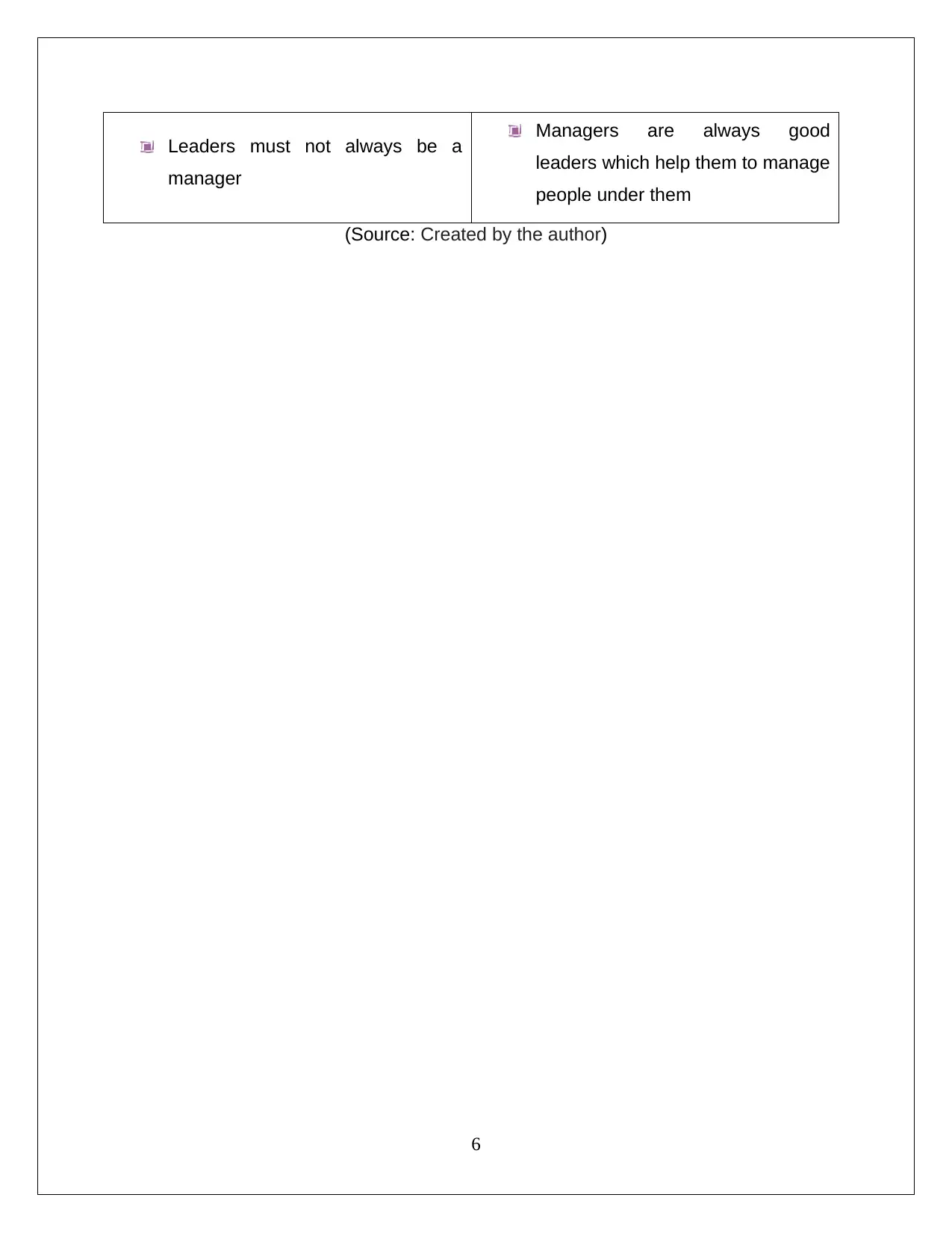
Leaders must not always be a
manager
Managers are always good
leaders which help them to manage
people under them
(Source: Created by the author)
6
manager
Managers are always good
leaders which help them to manage
people under them
(Source: Created by the author)
6
⊘ This is a preview!⊘
Do you want full access?
Subscribe today to unlock all pages.

Trusted by 1+ million students worldwide
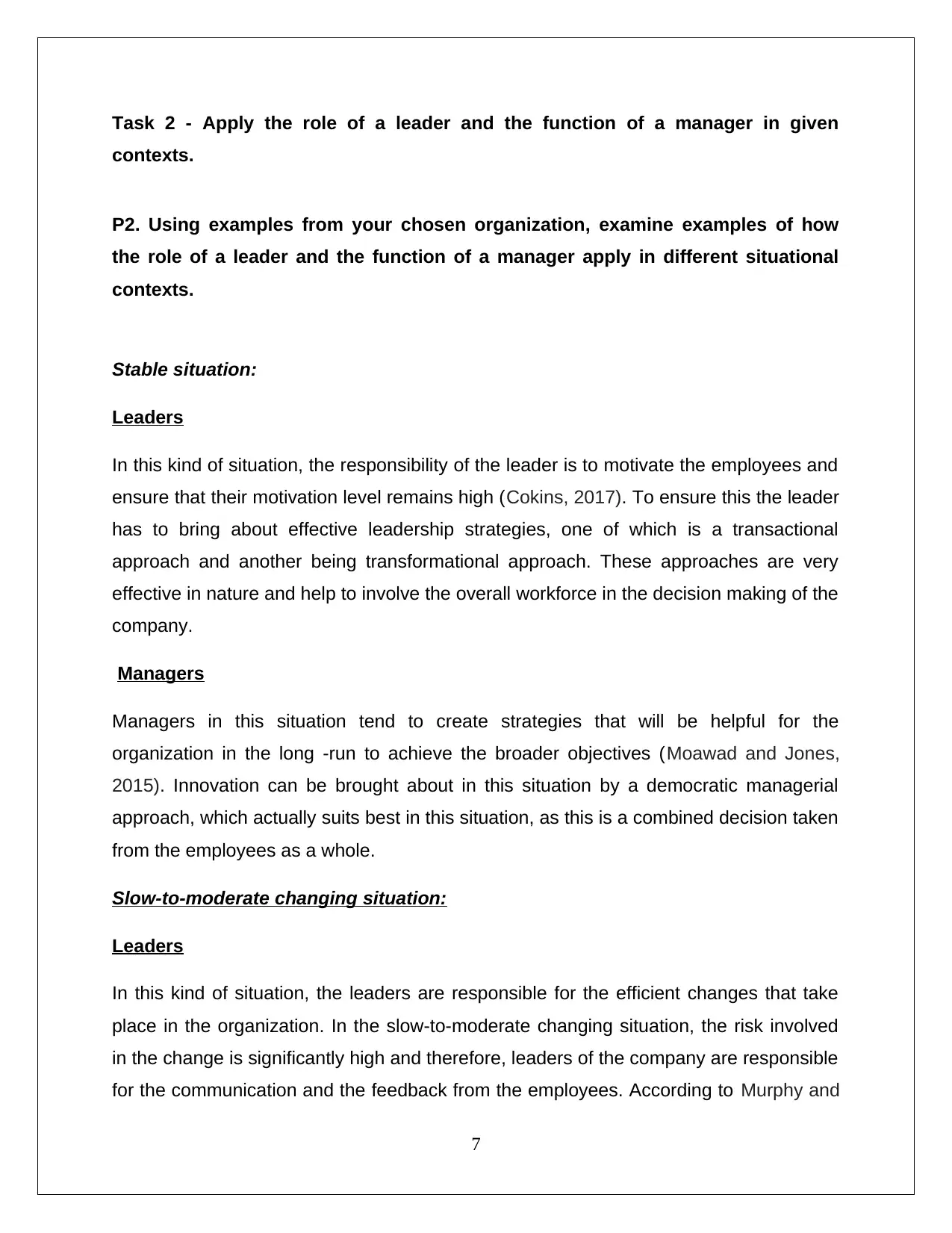
Task 2 - Apply the role of a leader and the function of a manager in given
contexts.
P2. Using examples from your chosen organization, examine examples of how
the role of a leader and the function of a manager apply in different situational
contexts.
Stable situation:
Leaders
In this kind of situation, the responsibility of the leader is to motivate the employees and
ensure that their motivation level remains high (Cokins, 2017). To ensure this the leader
has to bring about effective leadership strategies, one of which is a transactional
approach and another being transformational approach. These approaches are very
effective in nature and help to involve the overall workforce in the decision making of the
company.
Managers
Managers in this situation tend to create strategies that will be helpful for the
organization in the long -run to achieve the broader objectives (Moawad and Jones,
2015). Innovation can be brought about in this situation by a democratic managerial
approach, which actually suits best in this situation, as this is a combined decision taken
from the employees as a whole.
Slow-to-moderate changing situation:
Leaders
In this kind of situation, the leaders are responsible for the efficient changes that take
place in the organization. In the slow-to-moderate changing situation, the risk involved
in the change is significantly high and therefore, leaders of the company are responsible
for the communication and the feedback from the employees. According to Murphy and
7
contexts.
P2. Using examples from your chosen organization, examine examples of how
the role of a leader and the function of a manager apply in different situational
contexts.
Stable situation:
Leaders
In this kind of situation, the responsibility of the leader is to motivate the employees and
ensure that their motivation level remains high (Cokins, 2017). To ensure this the leader
has to bring about effective leadership strategies, one of which is a transactional
approach and another being transformational approach. These approaches are very
effective in nature and help to involve the overall workforce in the decision making of the
company.
Managers
Managers in this situation tend to create strategies that will be helpful for the
organization in the long -run to achieve the broader objectives (Moawad and Jones,
2015). Innovation can be brought about in this situation by a democratic managerial
approach, which actually suits best in this situation, as this is a combined decision taken
from the employees as a whole.
Slow-to-moderate changing situation:
Leaders
In this kind of situation, the leaders are responsible for the efficient changes that take
place in the organization. In the slow-to-moderate changing situation, the risk involved
in the change is significantly high and therefore, leaders of the company are responsible
for the communication and the feedback from the employees. According to Murphy and
7
Paraphrase This Document
Need a fresh take? Get an instant paraphrase of this document with our AI Paraphraser
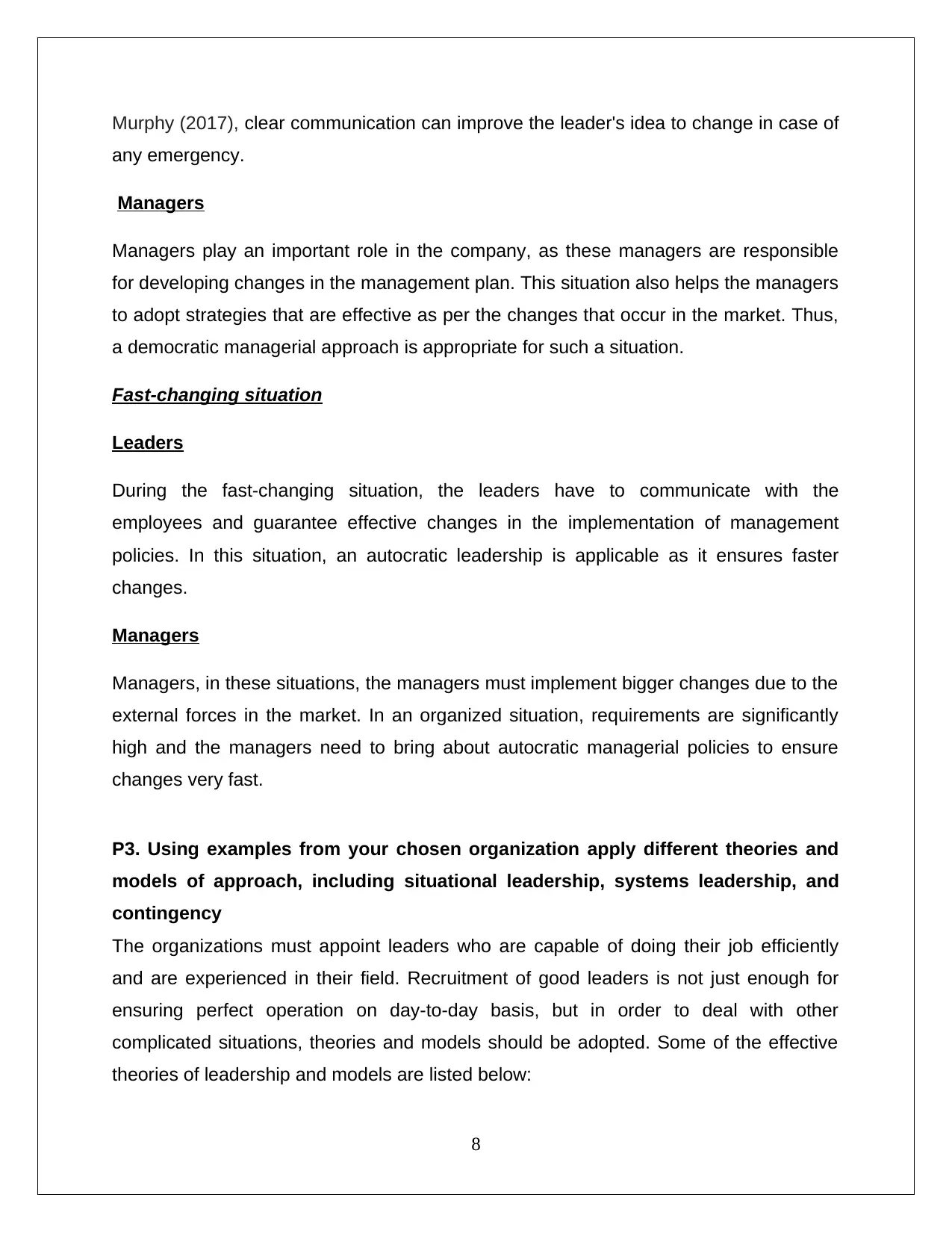
Murphy (2017), clear communication can improve the leader's idea to change in case of
any emergency.
Managers
Managers play an important role in the company, as these managers are responsible
for developing changes in the management plan. This situation also helps the managers
to adopt strategies that are effective as per the changes that occur in the market. Thus,
a democratic managerial approach is appropriate for such a situation.
Fast-changing situation
Leaders
During the fast-changing situation, the leaders have to communicate with the
employees and guarantee effective changes in the implementation of management
policies. In this situation, an autocratic leadership is applicable as it ensures faster
changes.
Managers
Managers, in these situations, the managers must implement bigger changes due to the
external forces in the market. In an organized situation, requirements are significantly
high and the managers need to bring about autocratic managerial policies to ensure
changes very fast.
P3. Using examples from your chosen organization apply different theories and
models of approach, including situational leadership, systems leadership, and
contingency
The organizations must appoint leaders who are capable of doing their job efficiently
and are experienced in their field. Recruitment of good leaders is not just enough for
ensuring perfect operation on day-to-day basis, but in order to deal with other
complicated situations, theories and models should be adopted. Some of the effective
theories of leadership and models are listed below:
8
any emergency.
Managers
Managers play an important role in the company, as these managers are responsible
for developing changes in the management plan. This situation also helps the managers
to adopt strategies that are effective as per the changes that occur in the market. Thus,
a democratic managerial approach is appropriate for such a situation.
Fast-changing situation
Leaders
During the fast-changing situation, the leaders have to communicate with the
employees and guarantee effective changes in the implementation of management
policies. In this situation, an autocratic leadership is applicable as it ensures faster
changes.
Managers
Managers, in these situations, the managers must implement bigger changes due to the
external forces in the market. In an organized situation, requirements are significantly
high and the managers need to bring about autocratic managerial policies to ensure
changes very fast.
P3. Using examples from your chosen organization apply different theories and
models of approach, including situational leadership, systems leadership, and
contingency
The organizations must appoint leaders who are capable of doing their job efficiently
and are experienced in their field. Recruitment of good leaders is not just enough for
ensuring perfect operation on day-to-day basis, but in order to deal with other
complicated situations, theories and models should be adopted. Some of the effective
theories of leadership and models are listed below:
8

Situational Leadership – This is an effective theory of leadership by Kenneth
Blanchard and Paul Hersey, which helps in portraying that no such theory, in
reality, is suitable for dealing with situations (Bolden, 2016). Moreover, the
leader should adapt to different styles of leadership for evaluating the employees’
ability to work in an organization. Just as if the employees of Volkswagen who
have low efficiency are managed with directing behavior and the ones, which are
highly able, are led through delegating behavior.
Systems leadership – This is another kind of leadership theory, which assists
the progress of the organization towards the social changes and the progress.
This also states that every organization is a large organization and that the
quality of outputs is directly related to the quality of outputs (Goetsch and Davis,
2014). The operation managers of the Volkswagen Group create new and strong
systems, which in turn leads to a better work culture and focuses on the
achievements of the company’s goals.
Contingency leadership – According to the policies laid down by Fred Fiedler,
this theory in another way claims that there are no perfect rules or theory to
leadership, organizing resources of the company or the decision-making process.
Instead, it states that appropriate actions are to be taken depending on the
internal and external situations of the firm. Thus, as an example, if the leaders of
the Volkswagen group notice any employee conflicts then the contingent leaders
take over and lead their subordinates in such a way that stronger bonding are
formed and the conflict ends.
9
Blanchard and Paul Hersey, which helps in portraying that no such theory, in
reality, is suitable for dealing with situations (Bolden, 2016). Moreover, the
leader should adapt to different styles of leadership for evaluating the employees’
ability to work in an organization. Just as if the employees of Volkswagen who
have low efficiency are managed with directing behavior and the ones, which are
highly able, are led through delegating behavior.
Systems leadership – This is another kind of leadership theory, which assists
the progress of the organization towards the social changes and the progress.
This also states that every organization is a large organization and that the
quality of outputs is directly related to the quality of outputs (Goetsch and Davis,
2014). The operation managers of the Volkswagen Group create new and strong
systems, which in turn leads to a better work culture and focuses on the
achievements of the company’s goals.
Contingency leadership – According to the policies laid down by Fred Fiedler,
this theory in another way claims that there are no perfect rules or theory to
leadership, organizing resources of the company or the decision-making process.
Instead, it states that appropriate actions are to be taken depending on the
internal and external situations of the firm. Thus, as an example, if the leaders of
the Volkswagen group notice any employee conflicts then the contingent leaders
take over and lead their subordinates in such a way that stronger bonding are
formed and the conflict ends.
9
⊘ This is a preview!⊘
Do you want full access?
Subscribe today to unlock all pages.

Trusted by 1+ million students worldwide

Task- 3
P4. Using examples from your chosen organization, explain the key approaches
to operations management and the role that leaders and managers play.
The key role of an operations manager is to focus on the benefit of the organization by
ensuring that the products and services are as per the industry standards and the
correct method is being followed in the process (Heizer, 2016). In Layman’s language,
operation management involves the proper utilization of labor and materials in an
organization to production of goods and services actively for the maximization of profit
in an organization.
The operation manager of a company for enhancing the production process (Stevenson
and Sum, 2015) can use various approaches. The Volkswagen Group makes use of
various operation management methods in order to ensure the improvement in the day-
to-day functions of the organization. The approaches used by the company are as
follows:
Total Quality Management (TQM) – This approach is referred to as the system of
management based on certain principal. The principal states that all the members of an
organization should be committed to maintain the high standards of the production
process and all the operations of an organization (Dale, 2015). Volkswagen Group uses
this approach to ensure that all the employees contribute voluntarily to the improvement
of the quality of the products and services and the operations of the company.
Just In Time (JIT) – This approach can be taken by the organization to ensure an
effective management of operations. According to Shay (2015), JIT is a modern
strategy that is being used by companies or institutions in efficiency improvement and to
reduce discards by the receipt of inventories whenever it is required. This approach is
the key option enabling Volkswagen Group to meet the quality and quantity as per their
customers’ demands in time as per the terms and conditions.
10
P4. Using examples from your chosen organization, explain the key approaches
to operations management and the role that leaders and managers play.
The key role of an operations manager is to focus on the benefit of the organization by
ensuring that the products and services are as per the industry standards and the
correct method is being followed in the process (Heizer, 2016). In Layman’s language,
operation management involves the proper utilization of labor and materials in an
organization to production of goods and services actively for the maximization of profit
in an organization.
The operation manager of a company for enhancing the production process (Stevenson
and Sum, 2015) can use various approaches. The Volkswagen Group makes use of
various operation management methods in order to ensure the improvement in the day-
to-day functions of the organization. The approaches used by the company are as
follows:
Total Quality Management (TQM) – This approach is referred to as the system of
management based on certain principal. The principal states that all the members of an
organization should be committed to maintain the high standards of the production
process and all the operations of an organization (Dale, 2015). Volkswagen Group uses
this approach to ensure that all the employees contribute voluntarily to the improvement
of the quality of the products and services and the operations of the company.
Just In Time (JIT) – This approach can be taken by the organization to ensure an
effective management of operations. According to Shay (2015), JIT is a modern
strategy that is being used by companies or institutions in efficiency improvement and to
reduce discards by the receipt of inventories whenever it is required. This approach is
the key option enabling Volkswagen Group to meet the quality and quantity as per their
customers’ demands in time as per the terms and conditions.
10
Paraphrase This Document
Need a fresh take? Get an instant paraphrase of this document with our AI Paraphraser

Queuing Theory – The effective approach in operations management is queuing
theory, which deals in issues in queuing. As Kalashnikov (2013) states, the approach
deals in the improvement in the queuing system of the organization and plays an
important role in reducing the wait time for the customers at the same time increasing
the number of customers who can be served. Queuing theory is used in Volkswagen
Group to improve the customer service, traffic flow, improve shipping, etc.
Continuous Improvement – The continuous improvement approach also known as the
Kaizen effect adding to the effective approach list. It is concerned with the improvement
in the goods and services and the incremental breakthrough improvement processes.
Volkswagen Group utilizes the continuous improvement approach, which reduces or
eradicates defects in the production process, and removes activities that adds no value
to the organization.
Leaders and managers possess a prominent role in the operation management (Donate
and de Pablo, 2015). Volkswagen Group managers and leaders plays a prominent role
in the operations management in the of the company.
The following are the prominent roles of the operation managers:
The work related issues can be overcome by encouraging and inspiring the
employees such as the technicians and workers.
Engineers should be encouraged to design innovative and functional goods and
services.
The workers should be motivated to care about the production quality.
Employees should be motivated to perform their best and fulfill their duty.
It is important to convince the staff to utilize the resources available in the best
possible way.
The leaders should be hopeful and positive when operation fails.
11
theory, which deals in issues in queuing. As Kalashnikov (2013) states, the approach
deals in the improvement in the queuing system of the organization and plays an
important role in reducing the wait time for the customers at the same time increasing
the number of customers who can be served. Queuing theory is used in Volkswagen
Group to improve the customer service, traffic flow, improve shipping, etc.
Continuous Improvement – The continuous improvement approach also known as the
Kaizen effect adding to the effective approach list. It is concerned with the improvement
in the goods and services and the incremental breakthrough improvement processes.
Volkswagen Group utilizes the continuous improvement approach, which reduces or
eradicates defects in the production process, and removes activities that adds no value
to the organization.
Leaders and managers possess a prominent role in the operation management (Donate
and de Pablo, 2015). Volkswagen Group managers and leaders plays a prominent role
in the operations management in the of the company.
The following are the prominent roles of the operation managers:
The work related issues can be overcome by encouraging and inspiring the
employees such as the technicians and workers.
Engineers should be encouraged to design innovative and functional goods and
services.
The workers should be motivated to care about the production quality.
Employees should be motivated to perform their best and fulfill their duty.
It is important to convince the staff to utilize the resources available in the best
possible way.
The leaders should be hopeful and positive when operation fails.
11

Managers play an important role in the operation management (Heizer, 2016). The
managers of Volkswagen Group helps in improving the operation management by
performing the following roles –
The role of supervising and planning the production process along with the
manufacturing process and the production of goods and services
The process of acquisition, development and deliverance of the end product to
the consumers on the basis of their necessity and their demand.
Encouraging effectiveness of the operation by developing the knowledge of the
process of reducing the amount of wastage in the operation
The re-evaluation of current structures, development and implementation of new
processes in the operation
Controlling and organizing operations to improve the product processes
qualitatively and quantitatively.
P5. Using examples from your chosen organization explain the importance and
value of operations management in achieving business objectives.
The operation management can be analyzed based on the operation management in
the achievement of business objectives (Slack et al., 2013).
The business objectives of Volkswagen Group are as follows:
Operation management helps the company to improve its sales and ensures the
quality goods and services for reasonable price.
Operation management is a survival strategy for the institution. By the reduction
of production cost, eradication of wastage and the production of quality goods
and services ensure that the product is affordable to the consumers.
This also helps in scheduling the operations in an organization.
12
managers of Volkswagen Group helps in improving the operation management by
performing the following roles –
The role of supervising and planning the production process along with the
manufacturing process and the production of goods and services
The process of acquisition, development and deliverance of the end product to
the consumers on the basis of their necessity and their demand.
Encouraging effectiveness of the operation by developing the knowledge of the
process of reducing the amount of wastage in the operation
The re-evaluation of current structures, development and implementation of new
processes in the operation
Controlling and organizing operations to improve the product processes
qualitatively and quantitatively.
P5. Using examples from your chosen organization explain the importance and
value of operations management in achieving business objectives.
The operation management can be analyzed based on the operation management in
the achievement of business objectives (Slack et al., 2013).
The business objectives of Volkswagen Group are as follows:
Operation management helps the company to improve its sales and ensures the
quality goods and services for reasonable price.
Operation management is a survival strategy for the institution. By the reduction
of production cost, eradication of wastage and the production of quality goods
and services ensure that the product is affordable to the consumers.
This also helps in scheduling the operations in an organization.
12
⊘ This is a preview!⊘
Do you want full access?
Subscribe today to unlock all pages.

Trusted by 1+ million students worldwide
1 out of 18
Related Documents
Your All-in-One AI-Powered Toolkit for Academic Success.
+13062052269
info@desklib.com
Available 24*7 on WhatsApp / Email
![[object Object]](/_next/static/media/star-bottom.7253800d.svg)
Unlock your academic potential
Copyright © 2020–2025 A2Z Services. All Rights Reserved. Developed and managed by ZUCOL.





